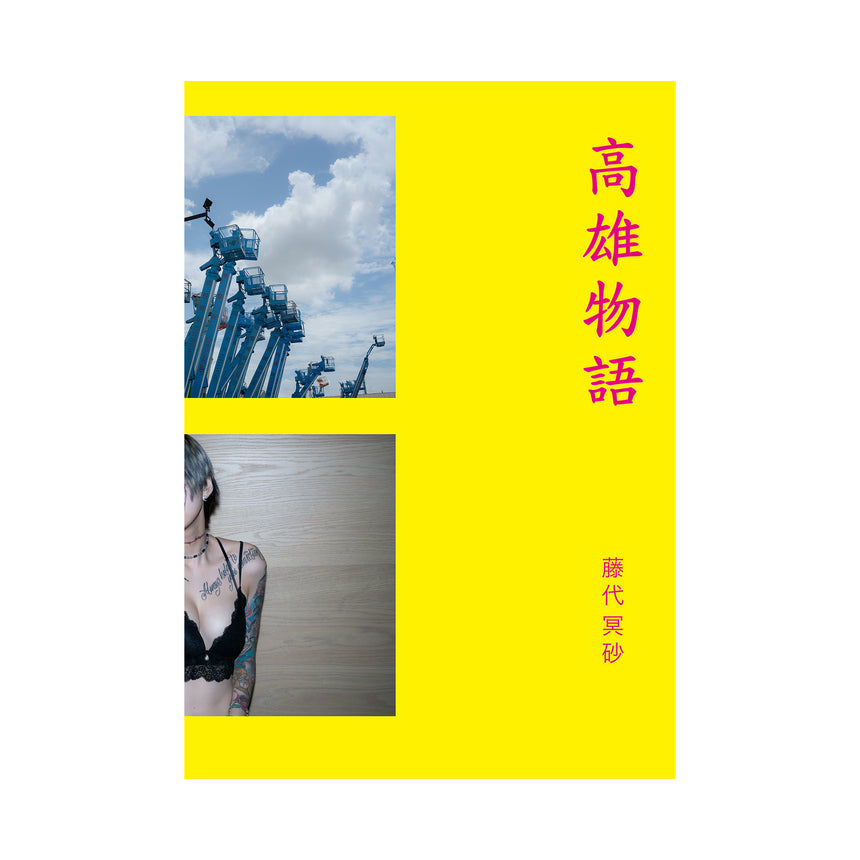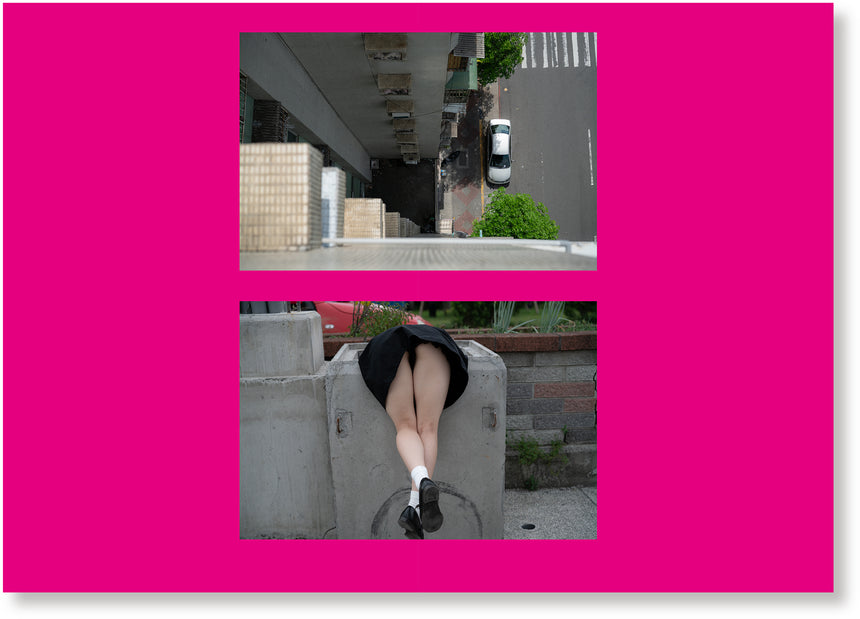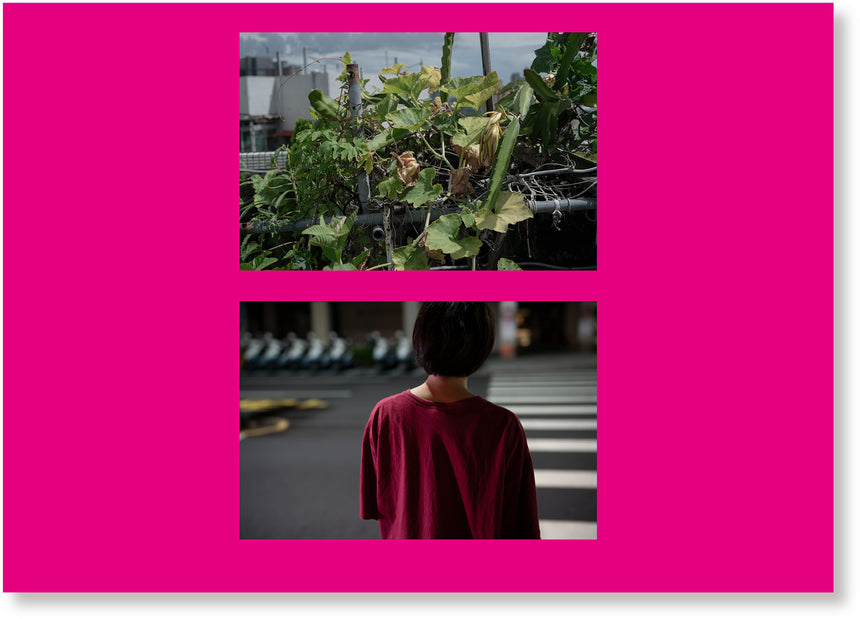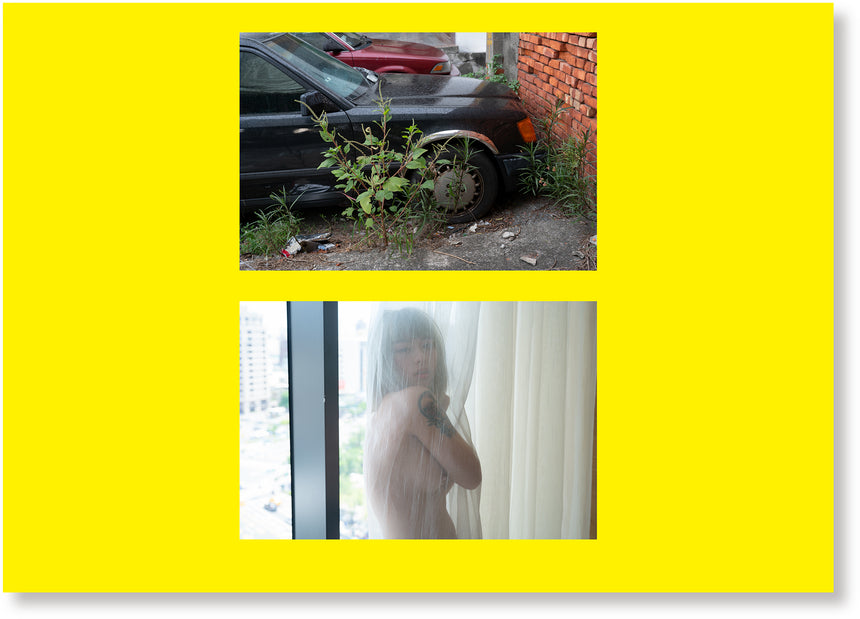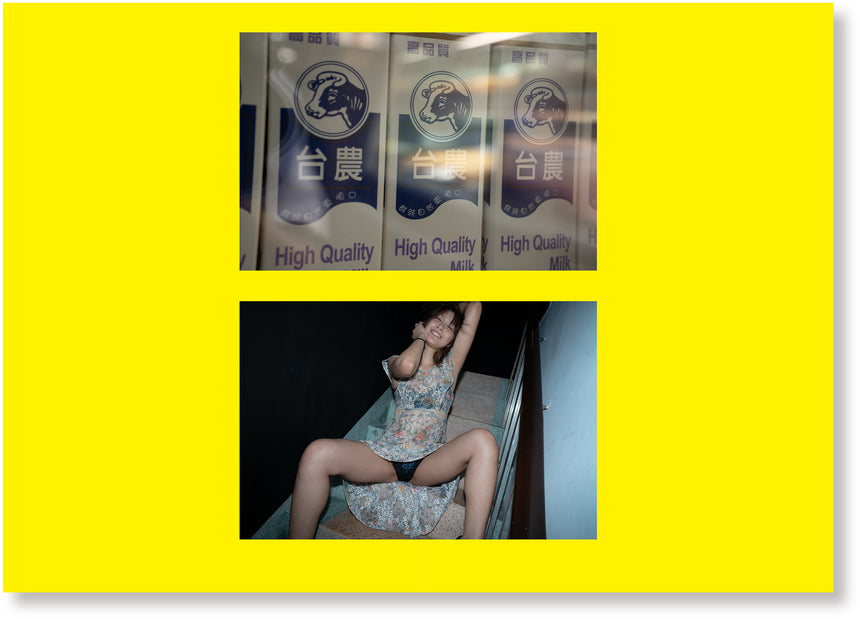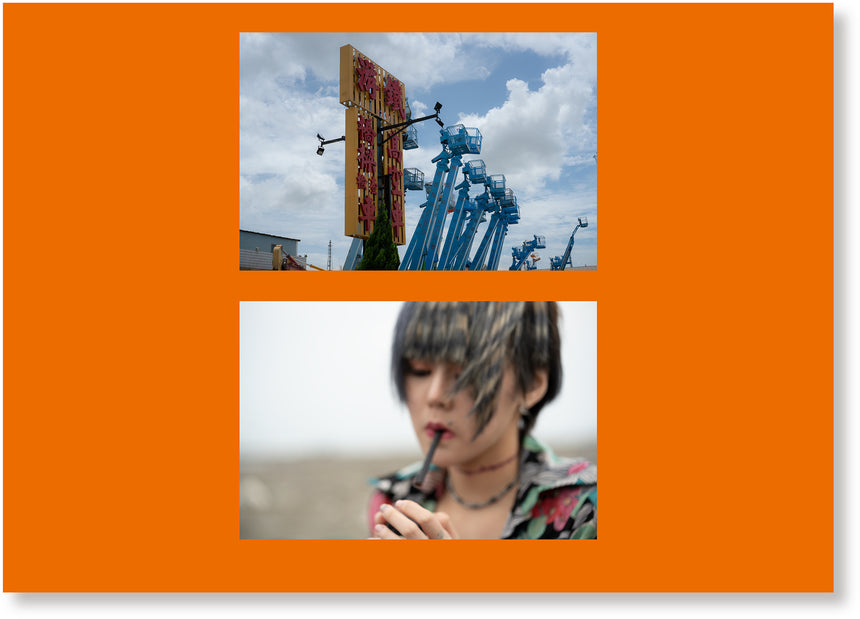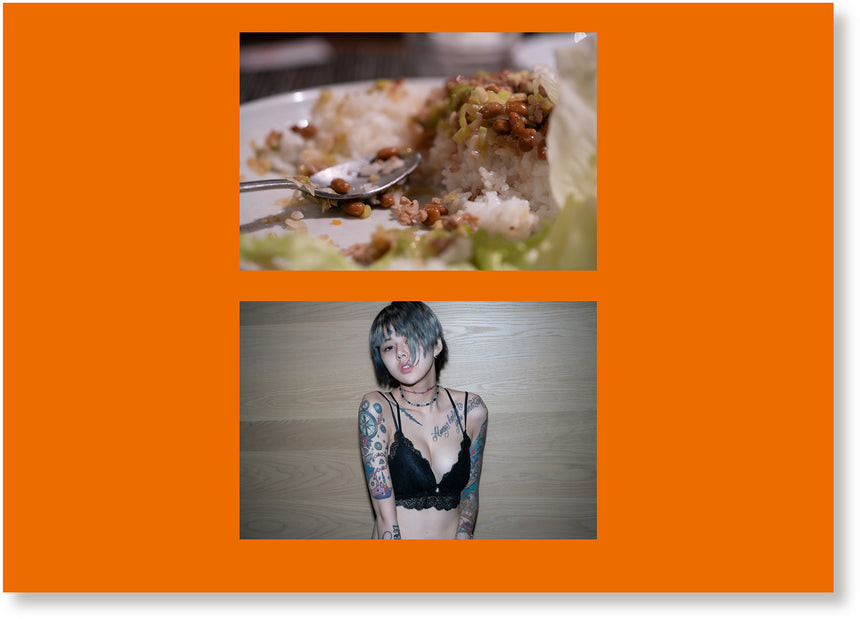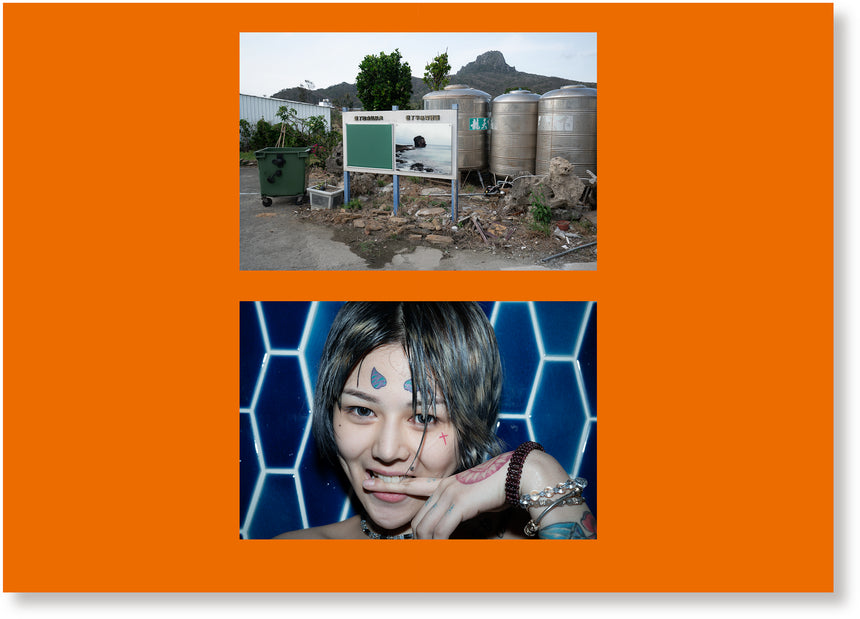KAOHSIUNG STORY / 高雄物語
Meisa Fujishiro
(藤代冥砂)
¥4,500 JPY
w17.5 x h25 cm
72 Pages
Softd cover(thread stitching)
Full color Offset
First edition
Published in 2024
ISBN 978-4-911112-08-3
"Kaohsiung Stories" consists primarily of images taken in the southern Taiwanese city of Kaohsiung in 2014, 2016, and 2017; in 2014, the images were taken during Fujishiro's personal journey. He met Stan Ao, a café owner living in Kaohsiung, through social networking, and hishis visit to him led to photographing local women.Through an arrangement with businessman Ame Chen, who met Mr. Ao at that time through his introduction, the project expanded into an invitational photo shoot in 2016 and 2017. Although not well known in Japan, at the time, Meisa Fujishiro was recognized as one of the leading figures in Taiwan's photography scene, as his photos and photo books featuring women from the 2000s, which crossed the border from Japanese gravure photography to art, were highly appreciated by some Taiwanese photography enthusiasts. Furthermore, "nudity as an expression" was also prevalent among Taiwanese women in front of the camera as models. It is interesting to note that women were beginning to actively view "nudity" and "sexual poses" as a form of expression, rather than as an object of one-sided male desire.While there, he photographed the works while conducting workshops and lectures. The women models standing in front of Fujishiro's camera were generally vivacious and had a firm sense of purpose. They appeared to Fujishiro to be a little different from Japanese models, full of a simple vitality.Fujishiro, who is always ready to shoot on the spot, shot the Kaohsiung shoot on his first visit, including the location and models. This was also a response to the heat of Taiwan and the city of Kaohsiung. After much shooting, much eating and drinking, and much sleeping, the materials for "Kaohsiung Story" were created by simply repeating this process. However, the publication of these materials had been postponed without any particular intention, and we can see a part of Fujishiro's rough character that even the timing of their release is a matter of fate. After having intentionally and accidentally released photo books in various genres, the last purely nude photo book by Fujishiro was "the skeches of tokyo" in 2016, and "Yama to Hada," which juxtaposes nudes with mountain photos, was released in 2017, so it is the first nude one for Fujishiro in a long time.Currently, Fujishiro is away from shooting nudes. Perhaps "Takao Monogatari" will mark the end of his nude film career. The title "Takao Monogatari" was inspired by "Tokyo Monogatari" by legendary Japanese film director Yasujiro Ozu. Although there is absolutely no coincidence between the two, the title juxtaposing the name of the city and the story has a nostalgic and universal sweep, and was necessary for Fujishiro to show his love for Taiwan and Kaohsiung.As for the contents of the photo book, as a whole, it is a tribute to the amount of light that fell on the tropical city, the attachment to the people and women who live there, and the comfort of being a foreigner. As for the bookmaking, I placed all the photographs in the center of the book, with holes in all of them, so that the threads would run through them. I did not want to put the photographs on a dais, but to give them a load, which symbolizes the discomfort that a photograph can have when it exists in society.Currently, Fujishiro is away from shooting nudes. Perhaps "Kaohsiung Stories"will mark the end of his nude film career. The title "Kaohsiung Stories" was inspired by "Tokyo Monogatari" by legendary Japanese film director Yasujiro Ozu. Although there is absolutely no coincidence between the two, the title juxtaposing the name of the city and the story has a nostalgic and universal sweep, and was necessary for Fujishiro to show his love for Taiwan and Kaohsiung.As for the contents of the photo book, as a whole, it is a tribute to the amount of light that fell on the tropical city, the attachment to the people and women who live there, and the comfort of being a foreigner. As for the bookmaking, I placed all the photographs in the center of the book, with holes in all of them, so that the threads would run through them. I did not want to put the photographs on a dais, but to give them a load, which symbolizes the discomfort that a photograph can have when it exists in society.
「高雄物語」は、2014、2016、2017年に台湾南部の都市高雄で主に撮影されたもので構成されている。2014年は、藤代の個人的な旅の途上で撮影された。高雄在住のカフェ経営者Stan Ao氏とSNSで知り合い、彼を訪ねることによって現地の女性を撮影することに発展した。その時にAo氏の紹介で知り合った実業家Ame Chen氏のアレンジによって、2016、2017年の招待撮影へと広がった。あまり日本では知られていないが、当時の台湾では、日本のグラビア写真をアートへと越境させた2000年代の女性を被写体とした写真や写真集が、台湾の写真愛好家の一部で高く評価されており、その代表的な存在の1人として藤代冥砂は認知されていた。さらにモデルとしてカメラの前に立つ台湾の女性にも「表現としてのヌード」というものが浸透していた。男性の一方的な欲望の対象としてではなく、女性が積極的に表現の1つとして「ヌード」や「性的なポーズ」を捉え始めていたのは興味深い。現地では、ワークショップや講演会をこなしつつ、作品を撮影していった。藤代のカメラ前に立つモデルの女性たちは、全体的に快活で、しっかりとした目的意思が感じられた。彼女たちは、日本人のモデルとは少し違っていて、素朴な生命力に満ちているように藤代には映っていた。元々、どんな現場でも出たとこ勝負な撮影をする藤代だが、高雄での撮影も、ロケ地やモデルも含め、初見でどんどん撮っていった。それは台湾の、高雄の街が持つ、熱量への反応でもあった。たっぷり撮り、たっぷり飲食し、たっぷり眠り、それをただ繰り返してできたのが「高雄物語」の素材であった。しかし、これらの素材は特に意図もなく、発表が延期になっていたのだが、出すタイミングさえも縁だとしている藤代のざっくりとした性格の一部が伺える。様々なジャンルの写真集を意図的に、偶発的に発表してきた藤代の純粋なヌード写真集は2016年『the skeches of tokyo』が最後になっており、ヌードと山岳写真を並べた『山と肌』は2017年発表であるから、藤代にとって久しぶりのヌードものだと言える。現在、藤代はヌード撮影から遠ざかっている。もしかしたら、『高雄物語』が彼のヌード作品としての区切りになるかもしれない。なお、タイトルの「高雄物語」は、日本の伝説的な映画監督小津安二郎氏の「東京物語」からインスパイアーされている。符合する点は全くないのだが、都市名と物語を並べるタイトルは、ノスタルジーと普遍的な広がりがあり、藤代が台湾や高雄に対する愛情を示すには、このタイトルが必要だった。写真集の内容については、全体として南国の都市に降り注いでいた光量へのオマージュであり、そこに暮らす人々、女性への愛着であり、異邦人であることへの安らぎが、載っている。造本に関しては、写真に全て穴が空き、糸が通るようにと、全て中央に配置した。写真をひな壇に乗せるのではなく、負荷を与えたかったのであり、それは写真というものが社会に存在する時に抱えてしまう違和感を象徴させている。
w17.5 x h25 cm
72 ページ
並製本(ミシン綴じ)
カラーオフセット印刷
初版
Published in 2024
ISBN 978-4-911112-08-3
